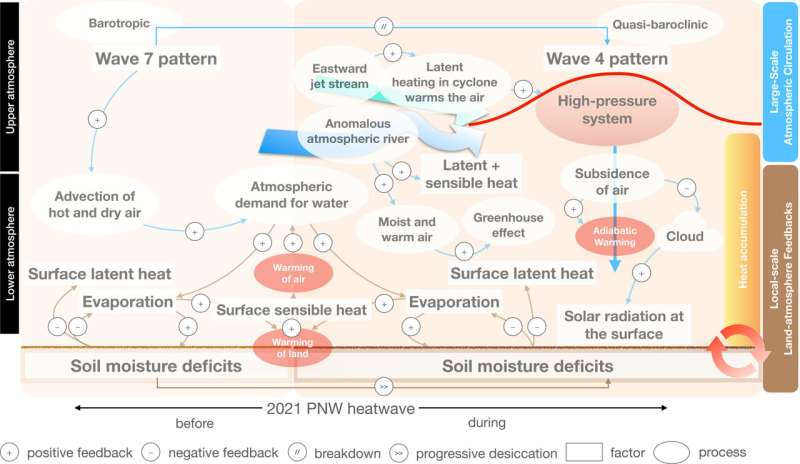This article has been reviewed according to Science X's editorial process and policies. Editors have highlighted the following attributes while ensuring the content's credibility:
fact-checked
peer-reviewed publication
trusted source
proofread
Climate change and atmospheric dynamics unveil future weather extremes

From late June to mid-July of 2021, the Pacific Northwest was scorched under an unprecedented heat dome, shattering temperature records and igniting a wave of concern over climate extremes. As cities like Portland and Seattle, known for their mild summers, grappled with triple-digit heat, scientists delved into the whys and hows of this meteorological anomaly.
Now, a collaborative team of researchers led by Michael Mann of the University of Pennsylvania's School of Arts & Sciences have peeled back layers of atmospheric dynamics to reveal a startling truth: The interplay of natural systems and human-induced climate change is setting the stage for more frequent and severe weather events.
"Our study shows that anomalous summer jet stream behavior—which we know is favored by human-caused warming yet isn't well captured by current generation climate models—contributed to the unprecedented 2021 Pacific Northwest 'Heat Dome' event," says Mann, Presidential Distinguished Professor and co-author of the paper published in the Proceedings of the National Academy of Sciences.
The researchers found that, prior to the heat dome event, the planetary wave—large-scale atmospheric fluxes in winds that cause weather change—over the Pacific Northwest amplified due to resonance, which is a related process where certain atmospheric conditions align in a way that reinforces the wave's strength and persistence.
The increase in the wave's amplitude likely resulted in a reduction of soil moisture in the region. The drier soil, in turn, contributed to an increase in atmospheric temperatures, a key factor in the extreme warming observed during the heat dome event.
The researchers note this complex interaction between the Earth's atmosphere and its terrestrial landscapes reveals an essential truth about extreme weather conditions: They don't occur in isolation but are the result of a series of interlinked processes.
Natural processes include atmospheric dynamics like air pressure and temperature variations, ocean currents, and natural climate cycles, while human-induced climate change involves alterations to the Earth's atmosphere due to emissions of greenhouse gases, deforestation, and urbanization. It's the synergy between these natural and human-driven processes that shape the frequency, intensity, and characteristics of these weather phenomena.
The team's work provides insights into the mechanics of this heat wave and pinpoints the significant roles of amplified atmospheric circulation patterns and soil moisture, an interplay that created the perfect conditions for a heat dome to form.
First author Xueke Li, a postdoctoral researcher in the Mann Research Group, explains that a phenomenon known as Quasi-Resonant Amplification (QRA) indirectly set the stage for the heat dome, "contributing to a deficit in soil moisture, which, in turn, amplified lower atmospheric warming."
Li notes that a longstanding climate science issue has been the models' ability to accurately replicate the intensity and frequency of extreme weather events. This difficulty is largely due to uncertainties in how atmospheric circulation and dynamics respond to climate change.
Their study underscores the need to integrate planetary wave dynamics into these models by incorporating QRA, which could significantly enhance the accuracy of predicting rare but impactful weather events.
"It is exciting to uncover the preconditioning feedback mechanisms of how QRA events may affect antecedent atmospheric conditions—in this case, through land-surface processes," says Li. "This introduces an additional, albeit indirect, mechanism through which QRA impacts extreme heat events."
This discovery holds promise for forecasting extreme "heat dome" events and for developing more accurate climate models.
More information: Xueke Li et al, Role of atmospheric resonance and land–atmosphere feedbacks as a precursor to the June 2021 Pacific Northwest Heat Dome event, Proceedings of the National Academy of Sciences (2024). DOI: 10.1073/pnas.2315330121
Journal information: Proceedings of the National Academy of Sciences
Provided by University of Pennsylvania





















